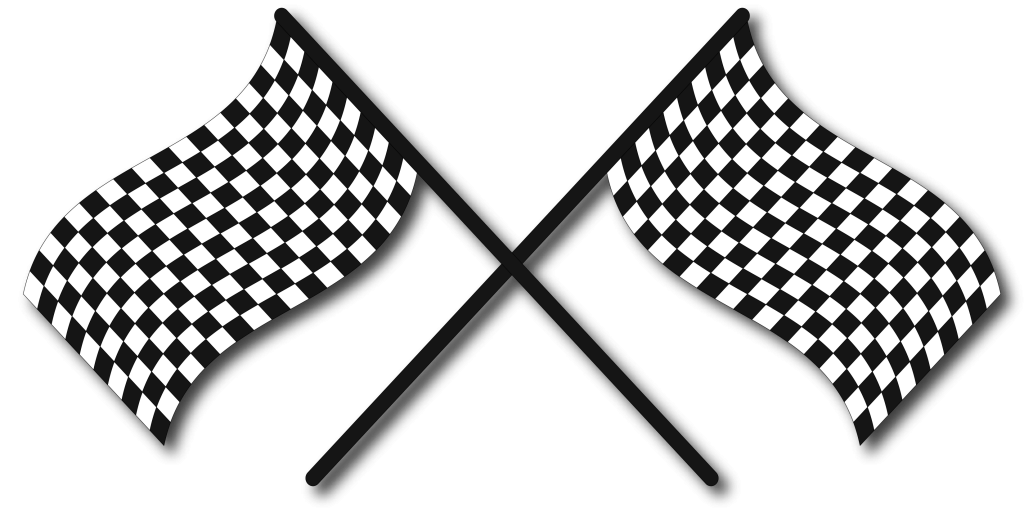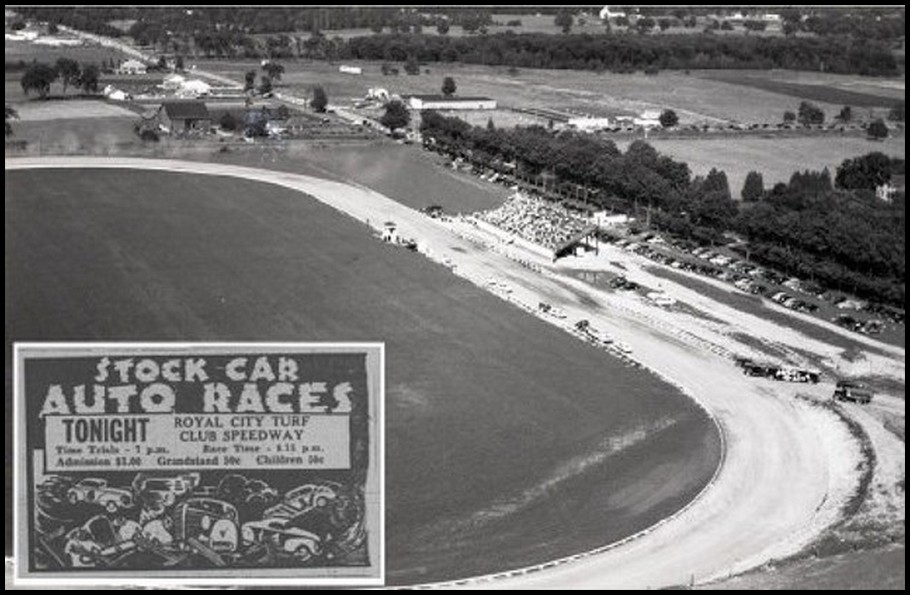Guelph, Ontario

George Lasby’s Royal City Turf Club 1/2 mile track, 1951, (Guelph, Ontario).
Inset: Ad for racing event from the Mercury, May 17, 1952.
Photo Courtesy of the Guelph Museums, 2014.84.753
LIVING: Mar 13, 2017 Article by Cameron Shelley, of the Waterloo Region Record
Flash from the Past
Heroic driving… with many exciting spills!
On Saturday, May 19, 1951, 1,200 people gathered at George Lasby’s Royal City Turf Club half-mile track to take in a new event.
Instead of harness horses pulling carts, they saw souped-up jalopies hurtling down the straightaways. They heard the clash of steel on steel as drivers jounced and jostled in the turns. They cheered as the winners took the checkered flag. Stock car racing had come to Guelph! It arrived somewhat by accident. George Lasby had no particular history with stock cars though he was a significant figure in the local sports scene as one of the founders and executives of the Guelph Biltmore Mad Hatters hockey club in 1947.
However, born into a farming family near Arkell Ont. in 1907, Lasby maintained a lifelong interest in cattle and horse breeding.
In 1950, he laid out a half-mile harness racing track on a farm on the Kitchener Highway (now Woodlawn Road) at the current site of the Skyjack Inc. Plant 2. Looking for some means to top up his return on investment, he decided to hold stock car races on the same oval on Saturday evenings.
Stock car racing originated in the U.S. south in the 1920’s where it was associated with Prohibition-busting bootleggers. Although the sport was somewhat sidelined in the Depression and the Second World War, interest in it picked up with postwar auto production. Horse-racing tracks were often pressed into service, as was the case in Guelph.
With its illicit associations and raw, aggressive energy, the sport proved popular with Guelphites. Crowds often exceeded the 1,100-seat capacity of the grandstand. The Monday edition of the Mercury conveyed breathless accounts or sometimes photos of racing exploits the previous weekend.
There were many exciting spills.
“Fans saw their first spill of the local season in the first race. Two cars converged on the far side of the track on the straightaway and one of them did a complete somersault, winding up on its roof with the wheels spinning in the air.”
“Several accidents enlivened the afternoon’s racing. Several cars plunged through the fence. Howard Hurst, of Buffalo, ripped through the fence near the grandstand, ran wild in the infield and smashed the P.A. horns on the sound car. He was only shaken up by his wild ride.”
“In the second semi, one car went out of control on the last turn, crashed through the guard rail and was heading straight for the spectators when the driver swung it back on the track.”
There was also heroic driving.
“Bradt extricated his battered jalopy from the several ingenious cul-de-sacs to beat the pack in the feature. He bunted the crowd’s favourite, Johnny Reick, into the infield to take the lead and he held it despite the frantic efforts of some of his competitors to send him spinning off the track. One thing about these stock drivers; they don’t observe any of the niceties recommended by the Highways Act.”
In August 1951, Lasby paved a quarter-mile track inside the larger oval. This move meant that cars could not get too far apart, thus multiplying the exciting encounters.
Local boys such as George Fox, Floyd Gray, and Bill Hamilton were cheered on by the home crowd, the latter perhaps being the Royal City’s top performer. However, the feature races were dominated by out-of-towners like Johnny Reick of Kitchener, Eric Bradt of Hamilton, and Max Armstrong of St. Marys.
The 1952 season finished at the end of September and all looked well for the future of stock car racing. However, the wheels came off as Guelph annexed the area in 1953 and zoned it for industrial development. General Electric bought the property and built its new plant there. Today, the old track plot lies between the parking lot of Skyjack Inc. Plant 2 and the Canadian National Railway line to its east.
George Lasby died in 1960 and was inducted into the Guelph Sports Hall of Fame as a ‘Builder’ in 2005.


